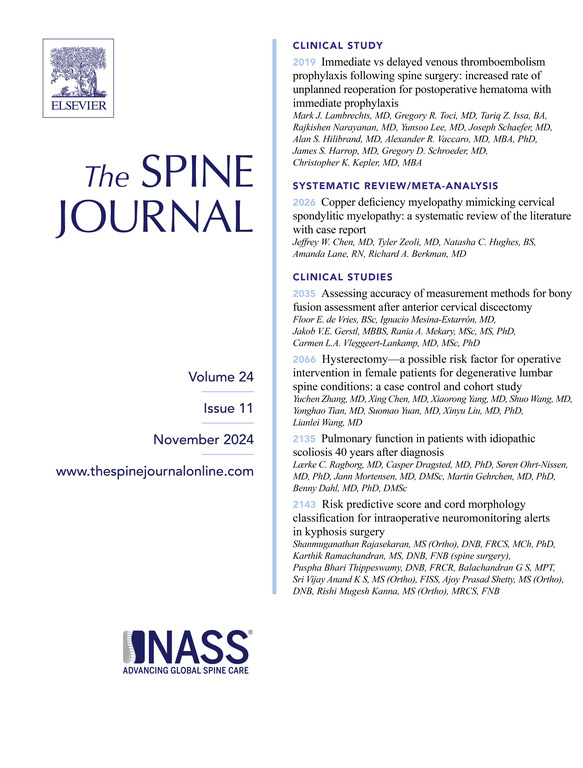Impact of incidental dural tears on postoperative outcomes in patients undergoing cervical spine surgery: a multicenter retrospective cohort study
IF 4.9
1区 医学
Q1 CLINICAL NEUROLOGY
引用次数: 0
Abstract
BACKGROUND CONTEXT
Incidental dural tear (DT) during cervical spine surgery is a feared complication. However, its impact on patient-reported outcomes (PROs) remains unclear.
PURPOSE
To determine the influence of DTs on PROs 1 year after cervical spine surgery.
STUDY DESIGN
Retrospective cohort.
PATIENT SAMPLE
Patients undergoing elective cervical spine surgery for cervical spondylosis, ossification of the posterior longitudinal ligament (OPLL), and cervical disc herniation.
OUTCOME MEASURES
Analysis included patients’ characteristics, perioperative complications, and PROs both preoperatively and at 1 year postoperatively.
METHODS
This study enrolled consecutive patients who underwent elective cervical spine surgery at 13 high-volume spine centers. All patients were required to complete questionnaires both preoperatively and 1 year postoperatively, which included PROs such as numerical rating scales of pain or dysesthesia for each part of the body, Neck Disability Index NDI, and Core Outcome Measures Index. Patients were divided into 2 groups based on the presence (DT+) or absence (DT-) of dural injury. Comparisons were made regarding patient background, perioperative complications, and pre and postoperative PROs. Propensity score matching was also utilized to adjust for patient background, and further comparisons were made regarding complication rates and PROs.
RESULTS
Out of 2,704 patients, dural tears were identified in 97 (3.6%) cases. The DT+ group had a significantly higher proportion of fixation surgeries, upper cervical surgeries, OPLL, and revision surgeries. Perioperative complications were significantly higher in the DT+ group, including intraoperative nerve damage, postoperative paralysis, surgical site infections (SSI), and cerebrovascular complications. Outcomes collected from 2,163 patients (79.9%) revealed significantly more severe neck and upper limb pain in the DT+ group. After propensity score matching, significant differences persisted in postoperative paralysis and SSI in the DT+ group, but no significant differences were observed in PROs.
CONCLUSIONS
Patients with dural tears showed nearly equivalent postoperative outcomes at 1 year following cervical spine surgery compared to those without dural tears. However, the incidence of perioperative complications was higher, emphasizing the need for careful management.
颈椎手术患者意外硬膜撕裂对术后效果的影响:一项多中心回顾性队列研究
背景情况:颈椎手术中的意外硬膜撕裂(DT)是一种令人恐惧的并发症。目的:确定颈椎手术一年后硬膜撕裂对PROs的影响:研究设计:回顾性队列:患者样本:因颈椎病、后纵韧带骨化症(OPLL)和颈椎间盘突出症而接受择期颈椎手术的患者:分析包括患者特征、围手术期并发症以及术前和术后一年的PROs:本研究招募了在 13 家大医院脊柱中心接受择期颈椎手术的连续患者。所有患者均需填写术前和术后一年的调查问卷,其中包括PROs,如身体各部位疼痛或感觉障碍的数字评分量表、颈部残疾指数NDI和核心结果测量指数。根据硬脊膜损伤的存在(DT+)或不存在(DT-)将患者分为两组。对患者背景、围手术期并发症、术前术后PROs进行比较。此外,还利用倾向评分匹配来调整患者背景,并进一步比较了并发症发生率和PROs:在 2,704 例患者中,97 例(3.6%)发现硬膜撕裂。DT+组的固定手术、上颈椎手术、OPLL和翻修手术比例明显更高。DT+组的围手术期并发症明显较高,包括术中神经损伤、术后瘫痪、手术部位感染(SSI)和脑血管并发症。从 2,163 名患者(79.9%)中收集的结果显示,DT+ 组患者的颈部和上肢疼痛明显更严重。经过倾向评分匹配后,DT+组在术后瘫痪和SSI方面仍存在显著差异,但在PROs方面未观察到显著差异:结论:与无硬膜撕裂的患者相比,有硬膜撕裂的患者在颈椎手术后一年的术后效果几乎相同。结论:与无硬膜撕裂的患者相比,硬膜撕裂患者术后一年的疗效几乎相当,但围术期并发症的发生率较高,强调了谨慎管理的必要性。
本文章由计算机程序翻译,如有差异,请以英文原文为准。
求助全文
约1分钟内获得全文
求助全文
来源期刊

Spine Journal
医学-临床神经学
CiteScore
8.20
自引率
6.70%
发文量
680
审稿时长
13.1 weeks
期刊介绍:
The Spine Journal, the official journal of the North American Spine Society, is an international and multidisciplinary journal that publishes original, peer-reviewed articles on research and treatment related to the spine and spine care, including basic science and clinical investigations. It is a condition of publication that manuscripts submitted to The Spine Journal have not been published, and will not be simultaneously submitted or published elsewhere. The Spine Journal also publishes major reviews of specific topics by acknowledged authorities, technical notes, teaching editorials, and other special features, Letters to the Editor-in-Chief are encouraged.
 求助内容:
求助内容: 应助结果提醒方式:
应助结果提醒方式:


